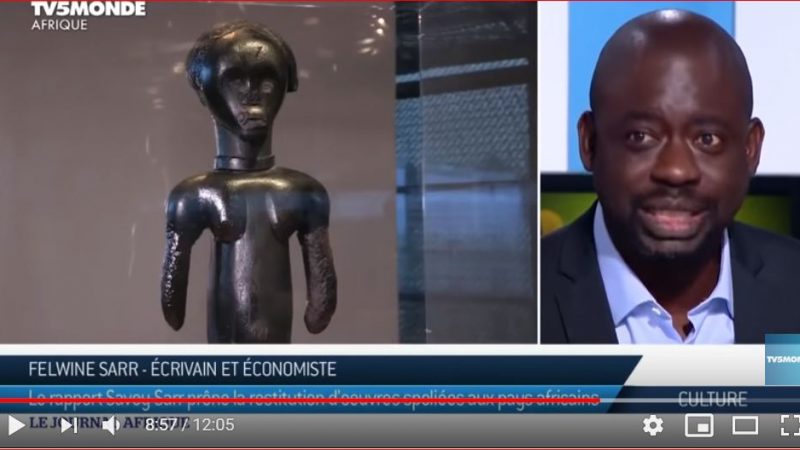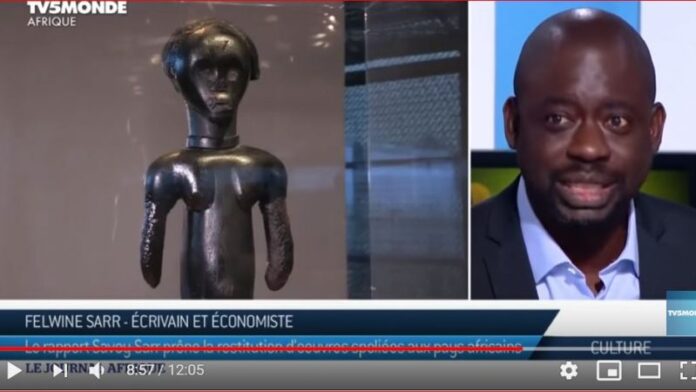
Screenshot of the French news channel TV5 Monde with Bénédicte Savoy and Felwine Sarr, two professors who are leading the conversation on repatriation of African heritage to countries of origin. Image via YouTube.
in November 2017, in a speech at the University of Ouagadougou, Burkina Faso, French President Emmanuel Macron declared that “African patrimony” should no longer be featured in European museums and that measures should be taken for its temporary or definitive restitution back to Africa.
Following this request, lecturers Felwine Sarr and Bénédicte Savoy from the University of Gaston-Berger in Saint-Louis, Senegal, and the Technische Universität of Berlin, Germany, wrote a report to explain a suggested legal process for returning Africa’s artifacts and treasures, rejecting the notion that these collections belong to French heritage.
The restitution of African art has been an ongoing debate for decades. European colonial powers used monumental archaeology to appear as the guardian of the colonized history, reinforcing an unconscious sense of ownership. Repatriation proponents say former colonial powers appropriated ancient art of colonized cultures and their museums, located in the West, prevent nationals from learning and embracing their own history.
Today, French public museums store about 90,000 sub-Saharan African art pieces, mostly obtained through theft and colonial privilege.
Journalists Konsimbo Ophelie and Poda Gabriel explain in Nsi mababu, a pan-African newspaper:
Plus de 90 percent des œuvres d’art d’Afrique noire se trouvent hors du continent, selon les experts. Pillées pendant la colonisation, elles sont pour la plupart aux mains du British Museum, du musée du Quai Branly, ou du musée de Berlin. Le Bénin, le Nigéria et la République Démocratique du Congo entre autres, réclament aujourd’hui le retour de ses trésors pillés durant l’époque coloniale. La question des restitutions d’oeuvres d’art africaines est à la fois épineuse, politique et constitue aujourd’hui une polémique dont il faut comprendre les tenants et aboutissants.
According to experts, more than 90 percent of black African artwork are found outside of the continent. Stolen during the colonization times, most of them are found in the property of the British Museum, the Quai Branly Museum, or the Berlin Museum. Today, countries like Benin, Nigeria and the Democratic Republic of Congo (among others) claim the return of their stolen treasures. The issue of the restitution contains tricky political elements. We need to understand the ins and outs of this.
Many African countries were affected by this looting, which represents 85 to 90 percent of African artistic heritage. Eva Rassoul, a journalist, explains on France Culture, a French radio program:
Dans les musées français, les œuvres africaines proviennent en grande partie du Tchad (9 200 œuvres), du Cameroun (7 800) et de Madagascar (7 500).
The artwork found in the French museums predominantly originate from Chad (9,200 artwork), Cameroon (7,800) and Madagascar (7,500).
Savoy and Sarr explained the legal process for repatriation of Africa’s stolen artificats on TV5 Monde:
Journalist Philippe Rey says the report looks at the role France played in the pillage of Africa’s heritage:
Il raconte les spoliations à travers l’histoire mondiale, évalue la part de la France, dresse un premier inventaire des oeuvres spoliées, fait le récit des tentatives des pays africains pour se réapproprier leur patrimoine, analyse les questions juridiques qui se posent, et énonce un certain nombre de recommandations pratiques pour la mise en oeuvre des restitutions, un des chantiers les plus audacieux de ce XXIe siècle.
It recounts the dispossession through the history of the world, evaluates the role of France, examines a preliminary inventory of the stolen artwork, narrates the African tentative for the heritage re-appropriation, analyses the legal questions, and lists a number of useful recommendations for the restitution process. This work is one of the most ambitious project of the 21st century.
Journalist Laurent Adjovi in Benin celebrates France’s move to return 26 artifacts taken from Benin:
Grâce aux discussions ouvertes avec la France, Patrice Talon offre ainsi une possibilité aux béninois de revoir par exemple les œuvres royales, évoquant les règnes des rois d’Abomey Ghézo (1818-1858), Glélé (1858-1889) et Béhanzin (1890-1894), des trônes, de récades, et les sceptres royaux.
Thanks to open discussions with France, Patrice Talon can offer Beninese people the chance to see some of their artwork again. An example of this is the royal artwork, showing the reigns of the kings Abomey Ghézo (1818-1858), Glélé (1858-1889) and Béhanzin (1890-1894), thrones, recades, and royal scepters.
In the spirit of showcasing African heritage and artifacts, Senegal unveiled the Museum of Black Civilizations on December 6, 2018, supported by Senegalese President Macky Sall. The museum adds to other cultural sites such as the House of Slaves and the Henriette-Bathily Women’s Museum.
Un évènement qui intervient au moment s’anime le débat sur la restitution des biens culturels africains pillés par la France pendant la colonisation. C’est un rêve vieux de cinquante ans qui se réalise.
This comes at a time where the debate is at its loudest concerning the stolen African cultural assets by France during the colonization. It is a fifty years old dream come true.
Ivory Coast’s minister of culture, Bandama Maurice, says repatriation of his country‘s historical artwork is definitely in the works:
Nous pensons qu’en 2019, tout ou en partie des 148 objets seront restitués à la Côte d’Ivoire. Nous avons demandé 148 parce que c’est ce que nous pouvons pour l’instant accueillir dans les caisses et les collections de nos musées.
We think that in 2019, most or all of the 148 artwork will be given back to Ivory Coast. The reason we have asked for this number is because we can only accommodate that many in the museum collections.
In the Republic of Congo, too, the Museum of the African Circle was recently inaugurated in Pointe-Noire, a port city, to invite youth to connect to their history and culture.
Ancien lieu culturel pour les congolais, avant d‘être transformé en Cour de justice et de finalement tomber à l’abandon, le bâtiment a été réhabilité et transformé en 2017 pour devenir ce musée. Depuis son ouverture au public le 4 décembre, le Musée du cercle africain a déjà accueilli plus de 600 visiteurs par mois.
Before being converted into a museum in 2017, this building used to be a former cultural place for Congolese people in the first place, then a law court and finally an abandoned place. Since its opening to the public on December 4, the Museum of the African Circle has already welcomed more than 600 visitors per month.
Nevertheless, the process to return African artifacts is difficult and many issues must be resolved before they can be returned. Journalist Yassin Ciyow raises the complexity of this process for Neomag magazine, stating how many of the acquired artifacts were technically given — or taken — as “gifts” during colonial periods.
En revanche, pour les œuvres issues de l’époque coloniale, la complexité vient du fait qu’après avoir été pillées, elles ont généralement été données ou léguées (dans le cadre légal de l’époque) à des collections publiques françaises. Ainsi, ces œuvres sont de facto entrées dans le domaine public mobilier national, devenant ainsi propriété de l’Etat français. Par le passé, des lois d’exception ont néanmoins été votées afin de “déclasser” certaines œuvres. C’est grâce à cette pirouette juridique que la Vénus Hottentote a pu être rendue à l’Afrique du Sud et des têtes maories à la Nouvelle-Zélande.
… [The] stolen artifacts from the colonial times were generally given or donated to French public collections. Thus, these artworks are de facto part of the national public domain, and have become a property of the French state. Nevertheless, exception laws have been voted in the past in order to decommission some works. It is because of this legal twist that the Venus Hottentote could be returned to South Africa, and the Maori heads to New Zealand.
Besides the legal difficulties, protection and maintenance of these rare African artifacts once returned has also raised concerns.
Article licenced under https://creativecommons.org/licenses/by/3.0/ Source: globalvoices.org
Welcome to www.network.wales
We’re your new go-to platform for connecting communities across Wales—through local news, petitions, events, and meaningful conversations.
Have something to share?
Whether you're passionate about writing, have a story to tell, or just want your voice heard, we’d love to hear from you! Contact Us Here or email: [email protected]




